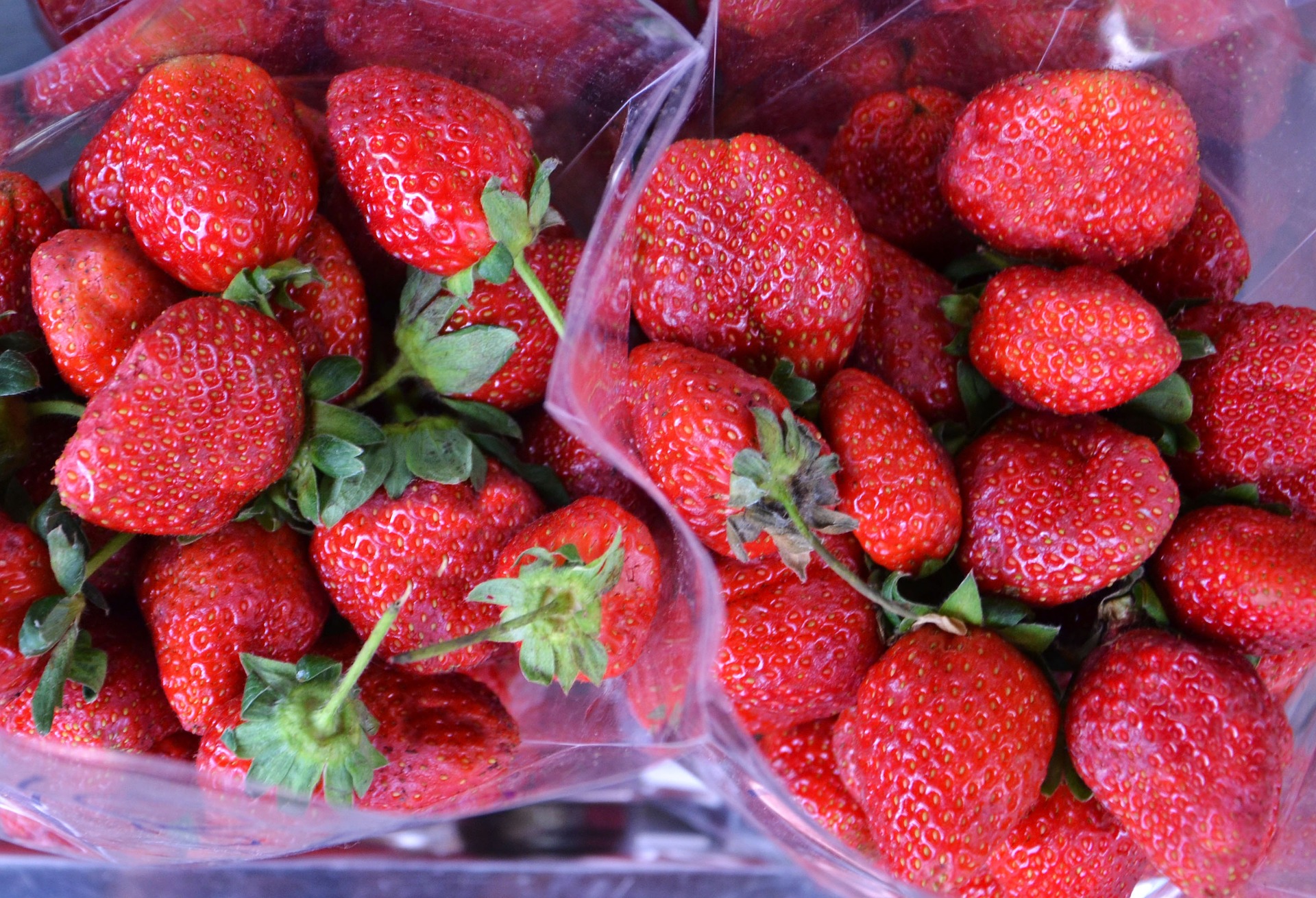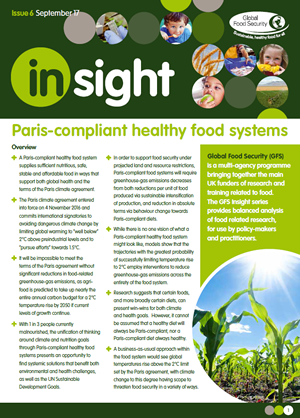
Transformation of the food system could lead the way in addressing both climate and health goals. The Global Food Security programme’s Sian Williams introduces a new report.
Entering into force on 4 November 2016, the Paris agreement saw all 197 parties to the United Nations Framework Convention on Climate Change (UNFCCC) pledge to avoid dangerous climate change by limiting global warming to ‘well below’ 2°C and to ‘pursue efforts’ towards 1.5°C (ref 1).
The path to Paris has been long and complex; calls for a global treaty on climate change started over 40 years ago with the first World Climate Conference and the initiation of the Intergovernmental Panel on Climate Change. To this end, the Paris agreement is certainly a huge diplomatic success, but the most difficult stage of the process is still to come – establishing and initiating the pathways by which this ambitious agreement can be achieved.
Since the agreement was ratified in 2016, a number of weaknesses in international commitment to the agreement have come to the fore, particularly relating to the withdrawal of the USA (though due to the agreement mechanism this departure cannot fully take effect until 2020) and recent reports of inaccurate emissions data that may fundamentally undermine the value of emissions reductions (ref 2).
While this paints a very bleak picture of progress since the milestone set at COP21, we must use this as further reason to galvanise new research and mitigation action to avoid dangerous climate change – and food could lead the way.

The link between food and climate
The global food system as a whole – everything from food production, transport, manufacturing, retailing, to consumer consumption and waste of food across all these stages – is currently responsible for around 30% of total anthropogenic greenhouse-gas (GHG) emissions (ref 3). Projections show that food-related emissions at current levels could account for the entire carbon budget for a 2°C temperature rise by 2050 (ref 4).
It is important to remember that, in turn, climate change to this degree – including both average changes in climate as well as increased volatility of extreme weather events such as storms, floods, droughts, and hurricanes – has scope to seriously threaten food security in a number of ways, from causing serious production shocks and restricting food accessibility, to devastating livelihoods reliant on agriculture and the wider food sector.
Clearly business-as-usual within the agri-food sector is not an option if we are to support the Paris agreement, and indeed, food security itself.

Paris-compliant healthy food systems
The latest report in the Global Food Security programme Insight considers this opportunity to transform the global food system, presenting the case for ‘Paris-compliant healthy food systems’ that unite thinking around sustainability and nutrition to find systemic solutions that address both challenges simultaneously.

Insight, issue six: Paris-compliant healthy food systems
GFS Insight aims to offer a balanced and interdisciplinary representation of the current state of knowledge in a particular area relating to food security. This issue outlines the need for a food system that supports both health and the Paris climate agreement, exploring impacts of food production and consumption as well as potential interventions to reduce greenhouse-gas emissions across the system.
(You can view PDF documents by downloading a PDF reader. We recommend using Google Chrome or Mozilla Firefox web browsers.)
We already know a great deal about current GHG emission hotspots in the food sector, as well as some potential mechanisms to reduce emissions per unit of food product produced; for example, ruminant feed containing methane inhibitors has been shown to reduce dairy cow emissions by 30% without affecting animal growth or milk production (ref 5). Recent interest in sustainable intensification has driven development and implementation of such efficiency improvements, greatly supporting a move towards Paris-compliant food production.

While it can’t be said that Paris-compliant diets are always healthy – for example, sugar is comparatively low in GHG emissions but must be limited in a balanced diet – there are certainly synergies. Evidence shows that if UK diets aligned with World Health Organisation recommendations, national greenhouse-gas emissions would drop by 17% (ref 6) and average life expectancy increase by 8 months (ref 7).
What next?
There is no one silver bullet by which Paris-compliant healthy food systems can be achieved and no one view of what this kind of system would look like in practice. Further research is needed to understand Paris-complaint systems in a more holistic way, tying down the optimum mixture of pre and post farm-gate interventions that will give the best chance of meeting Paris targets while still supporting food security and health.

We hope that by building a clearer picture of what a Paris-compliant healthy system might actually look like, this work will inspire and support transformation towards a Paris-compliant and healthier food future.
About Sian Williams
Sian studied Plant Sciences at the University of Cambridge before taking a Masters in Science Communication at Imperial College London. Sian is currently Analyst and Review Writer for the Global Food Security programme.
References
- United Nations: The Paris Agreement.
- BBC News: ‘Dodgy’ greenhouse gas data threatens Paris accord.
- Bajzelj, B., et al. Environ. Sci. Technol. 47, 8062−8069, doi:10.1021/es400399h (2013).
- Wellesley, L., et al. Changing Climate, Changing Diets: Pathways to Lower Meat Consumption (2015).
- Wollenberg, E., et al. Global change biology 22, 3859–3864, doi:10.1111/gcb.13340 (2016).
- Green, R., et al. Climatic Change 129, 253–265, doi:10.1007/s10584-015-1329-y (2015).
- Milner, J., at al. BMJ Open 5, doi:10.1136/bmjopen-2014-007364 (2015).




To learn more about healthy and nutritious food systems that also mitigate climate change see “Multifunctional Agriculture – Achieving Sustainable Development in Africa” published by Elsevier in 2017.
Recent research at James Cook University, Australia, is finding that Asparagoptis seaweed when added in quite small quantities to livestock feed is unique (as found so far) in its ability to reduce methane emissions to near zero.
See::
1. ‘Seaweed Project Targets Methane Emissions’, Meat and Livestock Australia, 18 September 2017
https://www.mla.com.au/news-and-events/industry-news/seaweed-project-targets-methane-emissions/
2. ‘Seaweed Fed Cows Could Solve Livestock Industry’s Methane Problems’ by Martin McCarty ABC News, ABC Rural 21 April 2017
http://www.abc.net.au/news/rural/2017-04-21/seaweed-fed-cows-could-solve-livestock-methane-problems/8460512
3. Robert D. Kinley et al ‘The Red Macroalgae Asparagopsis Taxiformis is a Potent Natural Antimethanogenic That Reduces Methane Production During in Vitro Fermentation with Rumen Fluid’ Animal Production Science, 2016, 56. pp282-289
http://dx.doi.org/10.1071/AN15576. Published online 9 February 2016
Thanks both for passing on those references!
Roger – your book makes an especially key point about the need for all sustainable development strategies to be tailored to local needs. While we have agreed to the Paris agreement and the SDGs as a global community, solutions will need to be viable for the nations implementing them.
Constance – that research sounds really promising and could definitely be a great component as part of a Paris-compliant system. I suppose the only question I would raise, is whether reduction in methane is enough to justify the trends of increasing meat consumption. For example, direct emissions from livestock would be reduced, but are there hotspots for emissions elsewhere in the production or supply chain we should also be targeting? Equally, this doesn’t overcome issues associated to high land-use for livestock production. As I point out in the report, it will be necessary to combine a range of different interventions across different parts of the system to optimise it fully.